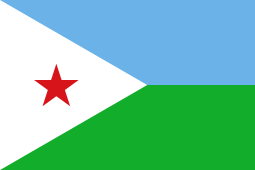Flag of Djibouti facts for kids
 |
|
| Use | National flag and ensign |
|---|---|
| Proportion | 2:3 |
| Design | A horizontal bi-color of light blue and light green, with a white isosceles triangle at the hoist bearing a red star in its center. |
The flag of Djibouti is a special symbol for the country. It has two equal stripes, one light blue on top and one light green on the bottom. On the left side, there is a white triangle. This triangle has a bright red star right in its middle.
Contents
What the Flag's Colors Mean
Each color and symbol on the flag tells a story about Djibouti. The light blue stripe stands for the sky and the Indian Ocean. It also represents the Issa people, who are one of the main groups in Djibouti.
The green stripe at the bottom shows the earth and the country's green areas. It also stands for the Afar people, another important group. The white triangle means peace and unity for everyone in Djibouti.
The Red Star's Symbolism
The red star in the middle of the white triangle is very important. The red color reminds people of the blood shed by heroes who fought for Djibouti's freedom. The star itself has five points, which stand for the five areas where Somali people live. It shows the unity of the Somali people in Djibouti.
History of the Djibouti Flag
Djibouti's flag was officially adopted on June 27, 1977. This was the day Djibouti gained its independence from France. Before this, Djibouti was known as the French Territory of the Afars and Issas. The design of the flag was chosen to represent the new, independent nation.
The flag's design was created by a group of people from different parts of Djibouti. They wanted a flag that would bring everyone together. It shows the hopes and dreams of the people for a peaceful and united future.
Images for kids
-
An old flag of the Ottoman Empire (1577–1793), used when parts of present-day Djibouti were under its rule.
See also
 In Spanish: Bandera de Yibuti para niños
In Spanish: Bandera de Yibuti para niños





